High Concept | Great Concept Cars of the ‘Current’ Age
Part 2
A couple of editions back, Motor Trader had a look at some of the best (in our opinion) concept cars of the internal combustion engine era.
There were some brilliant cars on that list, and all were in some way technologically and stylistically adventurous and innovative. However, there is no denying that in the automotive world right now, the future looks electric. Whether it be hybrid power, battery power or hydrogen fuel cell power, the era of automotive electrification is here.
That reality has been reflected in the past few years by an astounding number of electric concept cars. Everyone has got in on the fun – from a bewildering number of start-up companies to the giant legacy car manufacturers – and designers and engineers have let their imaginations run wild with the possibilities that electric power can offer. From incredibly powerful hypercars to the most luxurious of stately vehicles, from seemingly humble urban runabouts and personal mobility scooters to massive transportation trucks, no sector of the industry is being left out of the electrification boom.
Actually, it is not just the source of the power that has been the boon to this creativity. Other technologies – or at least the potential of emerging technologies – have appeared that have dovetailed with the development of electric power and it is now common to see concept cars stuffed full of gadgetry that allows cars to ‘talk’ to each other and infrastructure; that allows cars to ‘sense’ obstacles and traffic disruptions; that allows for permanent connectivity to the worldwide web; that enables a car’s software to be updated over the air, and that allows for a level of autonomy that is remarkable and growing ever more sophisticated.
Looking back at the history of the electrified vehicle, it is remarkable how things have turned out. 120 years ago, battery-powered vehicles were common in every nation that was beginning to produce motorised vehicles. That period of popularity was short as the potential of the internal combustion engine was realised and it wasn’t until the mid-1990s to the mid-2000s – and thanks to issues such as oil crises as well as environmental concerns – that clever people across the planet began to entertain the potential of electric power once more and hybrids such as the Prius, and all-electric vehicles such as the Tesla Roadster began to appear.
Leap forward 15 years and the current (excuse the pun) automotive world is a different place indeed.
Given the huge number of electric concepts that have appeared over the past decade, it is, once again, a difficult task to choose 10 such vehicles to be on our list. As we have said before, such a list is subjective.
However, here at Motor Trader we’ve given it a go once again and picked out some of the concepts that we think are important either for their technology or their design, or that just resonate with us.
We hope you enjoy the list.
Rolls-Royce 130EX || 2016

Rolls-Royce, the home of stately luxury, blew everyone’s minds back in 2016 when it revealed this, the 130EX concept.
It is an extraordinary looking machine and Rolls clearly felt when designing it that the future will be all-electric and driveless, and that the closer they could get to designing something that looked like it was in a sci-fi movie, the better.
Extraordinary looks aside, on the inside there is no steering wheel – autonomous driving technology is assumed – and where one might expect to see a dashboard full of guages there is instead a massive entertainment display. This is for the benefit of the passengers who occupy a ‘sofa’ where back seats might usually be found.
Also on hand is a AI-powered virtual personal assistant designed to learn the owner’s habits and even make suggestions on destinations – probably a swanky hotel or high-end restaurant right?
The exterior styling is, depending on your point of view, completely mad or very very slick, and includes enclosed 29-inch tall but narrow wheels, hand-built from 65 individual pieces of aluminium.
When the 103EX was revealed, Rolls said it was aiming for a return to its coach-building past with the car.
“Advanced manufacturing technologies will enable customers to involve themselves even more in the design of the shape, size and silhouette of their personal Rolls-Royce vision,” the company said. “The future customer will commission his or her own concept. and Rolls Royce will design and manufacture this personal vision of each customer and make every Rolls-Royce a unique bespoke masterpiece.”
It would take some doing to come up with something as novel and bonkers as this.
Mercedes Benz Vision AVTR || 2020

ANOTHER EXTREME DESIGN, this one from Mercedes, and if ever there was a concept that looked like the result of imagination run wild, then the AVTR is it. It is an extraordinary thing.
And it is a little more extraordinary than that, inspired as it was by the Hollywood sci-fi movie Avatar and that film’s look, feel and concept of humans and machines being able to interact with each other at a high level.
There is, apparently, a biometric connection feature in the AVTR that means ‘instead of a conventional steering wheel, the multifunctional control element in the centre console allows human and machine to merge. By placing the hand on the control unit, the interior comes to life and the vehicle recognises the driver by his or her heartbeat and breathing.’
This is wild stuff that is mirrored on the exterior where there are ‘bionic flaps’ or scales that affect aerodynamics. There are also spherical wheels that allow the car to move sideways by approximately 30 degrees.
Mercedes says the AVTR uses a graphene-based organic cell chemistry battery technology that is completely free of rare earths and metals, and the materials of the battery are, apparently, compostable and recyclable. With a capacity of around 110 kWh, the VISION AVTR has a range of more than 700km, and its four high-performance electric motors – one at each wheel – sees power come in at a juicy 350 kW.
We may not see the AVTR in a showroom any time soon, but it’s nice to dream.
Tesla Cybertruck || 2019
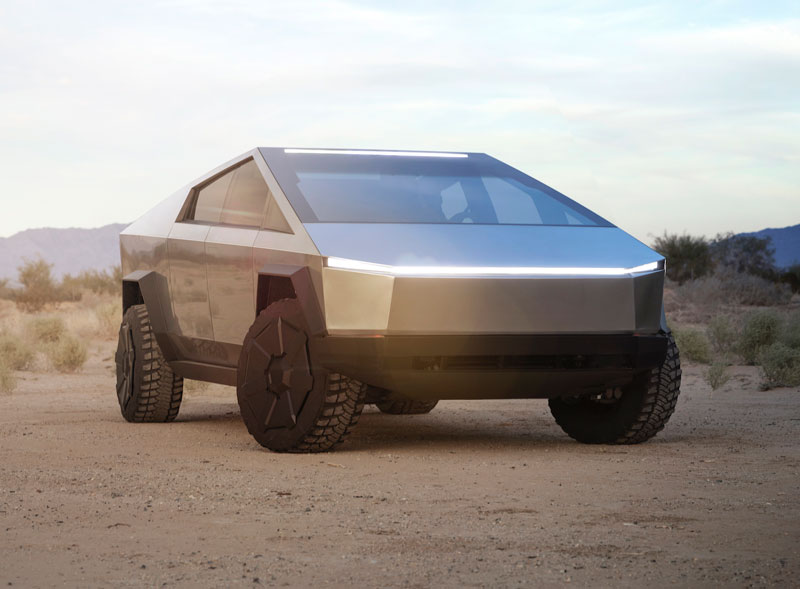
Tesla has been an automotive industry game-changer, and it’s not an exaggeration to suggest that the company is the main reason for the acceptance of EVs as a potentially profitable avenue for other manufacturers. Tesla saw there was a market there, judged that the public was interested, and went for it. Its success has seen every other manufacturer follow its lead, or try to.
Tesla takes risks – risks that tend to pay off. When, in 2019, the company’s enigmatic boss, Elon Musk, revealed the Cybertruck – a concept destined for production – it made headlines worldwide.
Following its reveal, the world was awash with commentary on the truck’s remarkable styling, but whether you think it is a piece of futuristic automotive art or the ugliest thing on four wheels, it is, at least, different. And in an age when new vehicles are often indistinguishable from each other, that has got to be a good thing.
The Cybertruck is due to go into production in 2021 and there will be three variants to choose from – a single-motor rear-wheel drive, a dual-motor all-wheel drive, and a tri-motor all-wheel drive. It will be constructed with a unibody/exoskeleton made from ‘ultra-hard 30x cold-rolled stainless steel’ that should, the company says, help ‘eliminate dents, damage and long-term corrosion’. Oh, and there’s armoured glass as well.
The top-spec tri-motor model has some astounding performance figures. Range is a claimed 800km, towing capacity is 6350kg, and payload capacity is 1590kg in a bed that is covered by a metal ‘canopy’ that retracts into the roofline, and the 0-100km/h time is, get this, 2.9 seconds . . . for a truck!
Love or hate the design, this could be another game-changer from Tesla.
Renault Trezor || 2016
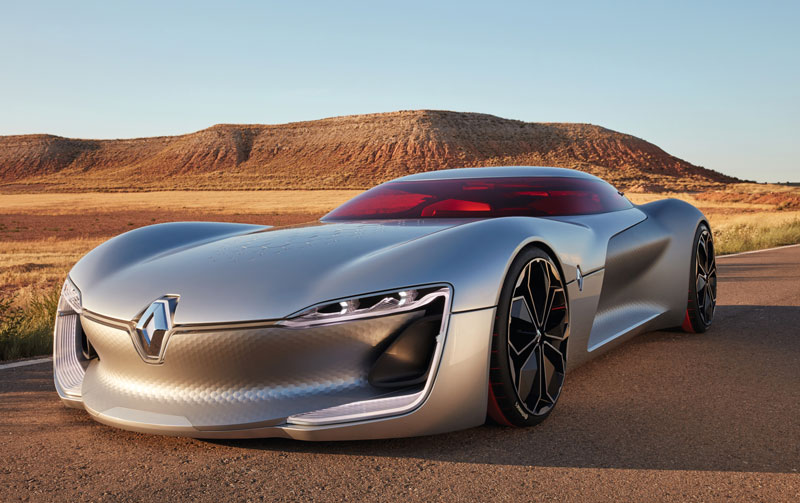
French manufacturer Renault has fully embraced the idea of electric vehicles. Its small car, the ZOE, is one of the world’s best-selling EVs and back in 2016, the company showed off its EV chops with the Trezor, surely one of the most beautiful concepts of recent years.
The Trezor has some performance pedigree. Renault says the car’s high-output powertrain is derived from the company’s Formula E sports car, meaning the technology is proven and potent. The Trezor’s Rechargeable Energy Storage System (RESS) comes from Formula E too and the powertrain produces 350hp (251kW) and 380Nm, giving the concept a 0-100km/h time of under four seconds. With a drag coefficient of 0.22, the Trezor can reportedly crack 250km/h.
Power comes via two battery packs, each with its own cooling system that includes the very futuristic honeycomb air intakes on the bonnet.
There are three driving modes – neutral, sport and autonomous – and getting in and out of the Trezor involves lifting the one-piece roof – a cool feature that Australians will remember being a feature of the splendid Holden Hurricane concept of the 1960s.
Inside, the dashboard design uses ultra-high-definition screens that can be personalised and which display the dashboard controls and the multimedia system.
This is one EV we’d like to see belting up and down the highway.
Hyundai Elevate Ultimate Mobility Vehicle || 2019
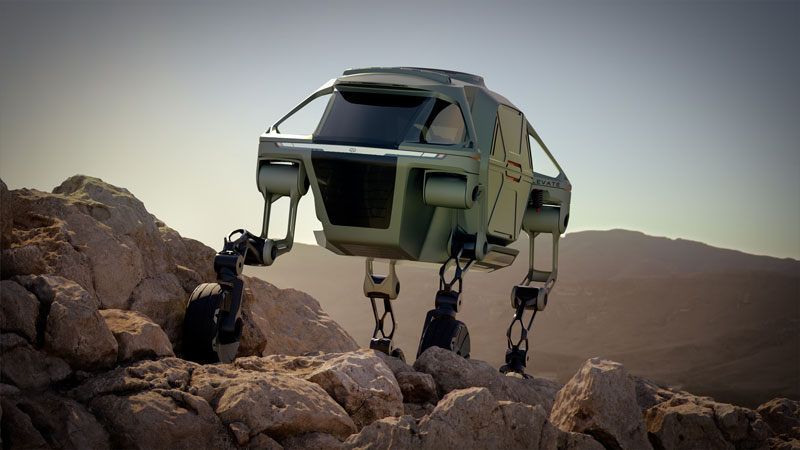
Concept vehicles are crafted to show the direction a manufacturer may take in the design of its production vehicles, highlight their technical and engineering skills, and display the types of technologies we can expect to see, in some form, in future production cars.
The results are often spectacular.
Sometimes, however, there is a leap of imagination even beyond that, and such is the case with Hyundai’s Elevate concept, a working model of which was revealed at the Consumer Electronics Show in 2019.
The Elevate was conceived as a vehicle to aid first responders following a natural disaster and enable search-and-rescue teams to negotiate treacherous terrain.
Thinking somewhat outside the box, Hyundai and its design partner Sundberg-Ferar, came up with the idea of creating a vehicle that combined tech found in EVs and robotics and that can both drive and walk.
The Elevate is based on a modular EV platform with a 66kWh battery pack, and its robotic leg architecture has five degrees of freedom plus wheel-hub propulsion motors. This design allows for both mammalian and reptilian walking gaits, enabling it to move in any direction. The legs can fold up and be stowed for drive mode.
Hyundai says the Elevate can climb a 1.5m wall, step over a 1.5m gap, walk across all manner of terrain, and achieve a 4.5m track width, all while keeping its passengers steady and level.
A full-sized version of the Elevate may not exist as yet, but the fact that such a vehicle is being proposed does show where technology can take us and what possibilities there are for future mobility vehicles.
Citroen AMI One || 2019

Cars with big enough batteries and potent enough electric motors are capable of extraordinary acceleration and exceptional speeds, and there are plenty of those vehicles on this list to prove that fact.
The other side of EVs, however, is their ability to be efficient, urban runabouts. In a busy city environment, so the argument goes, there simply is no need for vehicles that can go extremely fast and travel huge distances – what would be the point when you only go a few kilometres each day to the office and back and maybe to the shop to buy some essentials?
Citroen have taken the idea of the urban runabout one step further with the Ami One, pitching the quick-charging, ultra-compact two-seater – which has a range of 100km and a top speed of 45km/h – as an alternative to public transport, scooters and bikes. Citroen says it would make the Ami One available for use options including car-sharing and rental, as well as for purchase.
There’s some interesting stuff going on in the Ami One. For example, the door locks and unlocks via a QR code, and functionality comes via an app with the screen display projected into the driver’s field of vision like a head-up display.
Another interesting feature is that the bumpers, wings, panels and even the doors – which are hinged at the front on the passenger side and at the rear on the driver’s side – are identical.
The Ami One is pretty clever stuff and, perhaps, represents at least one avenue for the future of city transportation.
Lagonda Vision Concept || 2018
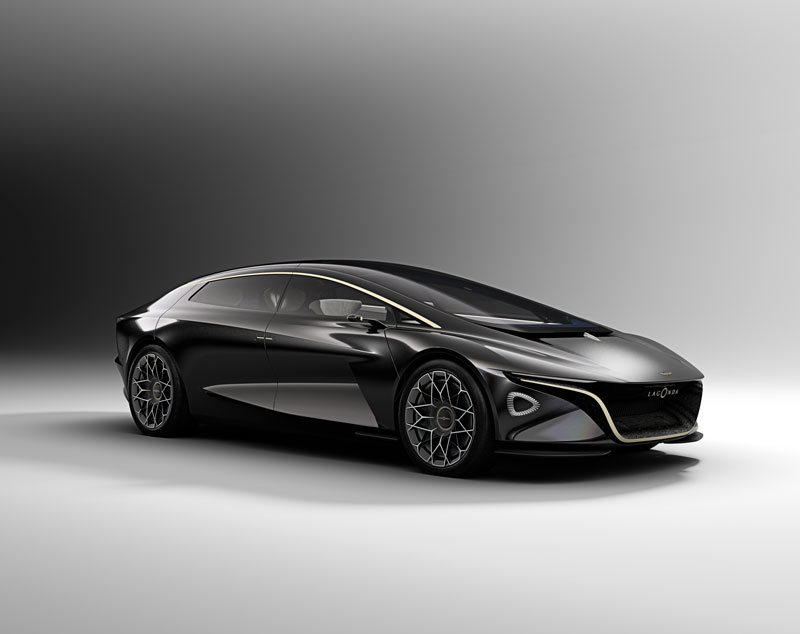
Back in 2018, Aston Martin revealed the Lagonda Vision Concept – the first concept for the company’s electric-only Lagonda luxury brand.
And ‘luxury’ is the word.
Not only does the sedan look like a billionaire’s ride from the outside, the inside space – which is huge thanks to there being no requirement to find room for an engine, gearbox and transmission – is stuffed with top-quality materials and technology. Carbon fibre and ceramics share space with old-world favourites such as cashmere, silk and hand-woven wool and, for good measure, Savile Row tailors were recruited for their expert knowledge in forming such luxury materials.
Clever features include rear-hinged back doors with roof sections that open upwards as the doors open. This allows for occupants to stand up and walk out of the car or step into it. The front seats are mounted on cantilevered arms extending from the floor outside the seat frame providing an uncluttered floor area, and can be swiveled so all passengers can face each other.
Designed with Level 4 autonomy in mind, the Vision Concept was designed with a steering wheel that can retract entirely. When not in autonomous mode, it can be moved from left to right hand drive as needed. Being fully ‘connected’ means passengers will have access to all manner of services, including bespoke concierge services.
The Lagonda Vision Concept was designed to use solid state batteries, be compatible with wireless conductive charging technology, have intelligent all-wheel drive, and be capable of delivering up to 100 per cent of available torque to any given wheel according to demand.
Back in 2018, Aston Martin swiftly followed up the Vision Concept with the Lagonda All-Terrain Concept, an all-electric SUV based on the same design language, and while the company has had its troubles of late, plans remain to launch a Lagonda EV range.
Audi AI: Trail Quattro || 2019
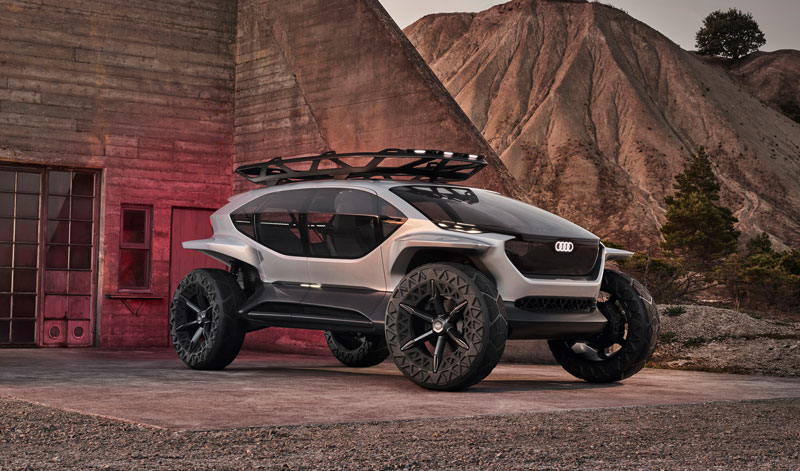
This is Audi’s entrant into the EV Off-Road concept segment – the AI:Trail Quattro. And it is a beauty, with some very tasty and unusual features wrapped up in that cool-looking package.
There’s Level 4 autonomous capability and, as the name implies, all-wheel drive thanks to four electric motors planted at each wheel. Maximum system output is 320kW and maximum torque comes in at a juicy 1000Nm. The AI:Trail’s lithium-ion battery is good for 400-500km of range on roads or easy-going terrain while on rough ground, range is still good at 250km. The vehicle is designed to reach a top speed of 130km/h on the road.
While EVs are, thanks to the battery packs, pretty hefty, the AI:Trail comes in relatively trim at 1750kg thanks to a construction mixture of steel, aluminium, and carbon fibre.
Befitting the expectations for rugged adventure, the interior is minimalist. There’s a yoke for a steering wheel, a few buttons, and if you attach a smartphone to the steering column, it can connect to the vehicle and become a display and control centre for a whole bunch of functions.
So far, so good.
However, the really jaw-dropping feature of the AI:Trail is that instead of conventional lights, it is equipped with five drones with integrated LEDs.
Yes. Drones.
Known as ‘Pathfinders’, these drones dock into charging elements on the roof and are designed to fly and illuminate the path ahead of the AI:Trail. On-board cameras generate a video image that is transmitted back to the driver’s display.
Crazy stuff!
Vision Mercedes-Maybach 6 || 2016
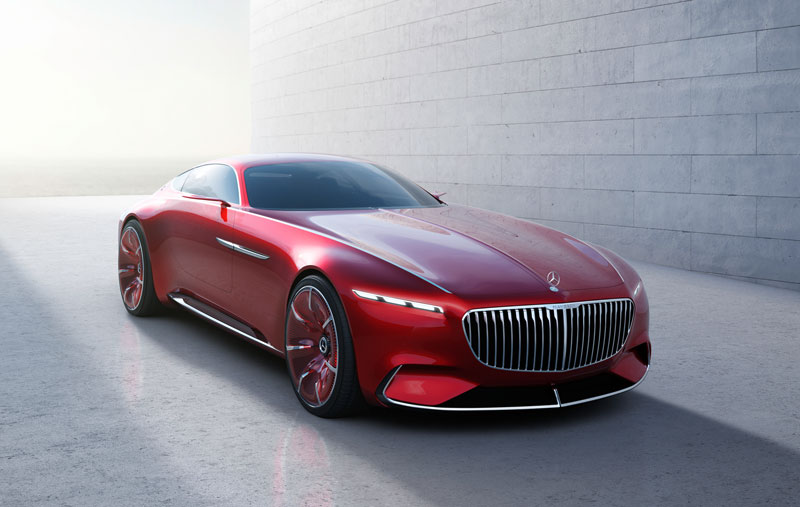
Mercedes-Benz have made some beautiful concept cars over the years but, just as with the AVTR that appears earlier in this list, every now and again they can reveal a concept that is a real showstopper.
Such is the case with the Maybach 6, perhaps one of the most graceful-looking concepts ever created and a creation from Mercedes uber-luxury Maybach brand.
At six metres long, the 2+2-seater Maybach is a big machine and with its long front end, gullwing doors and ‘boat tail’ rear, has a nice mix of modern and retro styling. Designed as an all-electric car with a drive system that generates 560kW, the Maybach 6 has a range of more than 500km. The battery has a usable capacity of approximately 80kWh and the system allows for a charging capacity of 350kW. The car can receive 100km of charge in five minutes.
Power delivery comes from four electric motors at each wheel and the system delivers performance figures of 0-100km/h in under four seconds and a top speed of 250km/h.
Inside, the Maybach 6 has a truly futuristic feel and is, as you’d expect, loaded with cutting-edge digital features – the front windscreen, for example, serves as a transparent display with driving-related data and other information shown across its full width.
The Maybach 6 is a work of art and while it might be a bugger to park, you’d look mighty good doing it.
GM Impact || 1990
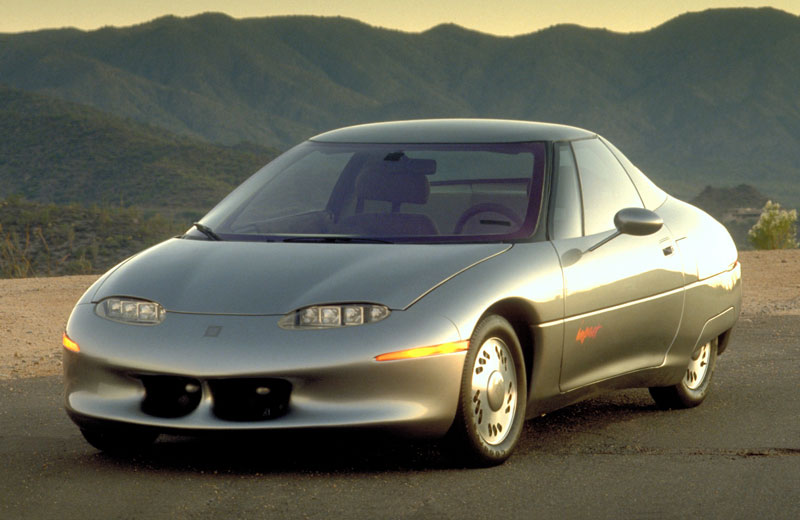
The GM Impact concept is, perhaps, the vehicle we can look back at as the origin of today’s EV revolution.
Revealed in 1990 at the LA Motor Show, the Impact was quick – it could top 190km/h and cover 0-100km/h in 8 seconds – and was fitted with innovative technology including regenerative braking. It was heavy, thanks in large part to the 32 lead-acid rechargeable batteries, but that was counteracted by the use of components such as low-rolling resistance tyres and an aerodynamic body that had a drag coefficient of just 0.19. Power was delivered by two electric motors – one at each front wheel – and the cruising range was a blockbuster 160km (this was 1990 remember).
When the Impact was unveiled, it was an experimental concept only, but GM said it was looking at making a production version. Six years later, it emerged as the EV1, the first purpose-designed electric car from a major manufacturer that was – or could be – mass produced.
Some 1100 EV1 units were made but its story is somewhat controversial. Production ended in 1999, and in 2002 GM announced that the leases for the EV1s would not be renewed. Sadly, the company took back the cars and almost all were destroyed.
Source: Motor Trader E-magazine (October 2020)
12 October 2020









